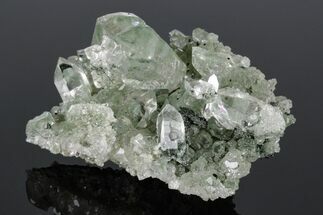This Specimen has been sold.
3.6" Precious, Ethiopian Fire Opal (128 g)
For the first time ever on FossilEra.com, we are pleased to present this 3.6" wide, kaleidoscopic, Ethiopian precious fire opal! These opals are phenomenally flashy and eye-catching. The amber orange body of this specimen is enhanced with a dancing play of color that flitters between blue, red, green, yellow and purple. Pictures simply can't do justice to the extreme beauty of this opal.
This specimen is in its raw, natural state with minimal matrix removal to expose more of the opal's inner beauty. As is, this specimen makes a stunning display piece but is also perfect for shaping and polishing by an experienced lapidarist.
The opal is shipped with a small amount of water to maintain hydration until the customer decides how to keep the specimen.
This specimen is in its raw, natural state with minimal matrix removal to expose more of the opal's inner beauty. As is, this specimen makes a stunning display piece but is also perfect for shaping and polishing by an experienced lapidarist.
The opal is shipped with a small amount of water to maintain hydration until the customer decides how to keep the specimen.
About Ethiopian Fire Opal
Opal is a gemstone that has captured the attention of the masses for centuries. Ethiopian opal, or Welo opal, is no exception to the rule. These stones have some of the most vibrant play of color on the market. These gemstones are the proverbial new kids on the block: they were discovered in the mid 1990s, and significant deposits emerged in 2008 and 2013. Since their discovery in the northern region of Ethiopia, these opals have swiftly taken the gem trade by storm and it's easy to see why.
Opal has various forms, but the primary variety that comes out of Ethiopia are precious fire opals. This name tells you two very important things about the opal. “Fire“ refers to the orange-red to amber coloring of the stone as a whole, and “precious” alludes to the play of color that the opal exhibits as light hits it. Unlike many of the other popular opals on the market that form in sedimentary environments, Ethiopian opal forms in igneous rock where volcanic activity was known to occur. Ethiopian opal is known as a hydrophane opal: this means that the opal is extremely porous and apt to absorb water easily. When the opal has absorbed a fair quantity of water it may appear more translucent than when in air.
Opal is a gemstone that has captured the attention of the masses for centuries. Ethiopian opal, or Welo opal, is no exception to the rule. These stones have some of the most vibrant play of color on the market. These gemstones are the proverbial new kids on the block: they were discovered in the mid 1990s, and significant deposits emerged in 2008 and 2013. Since their discovery in the northern region of Ethiopia, these opals have swiftly taken the gem trade by storm and it's easy to see why.
Opal has various forms, but the primary variety that comes out of Ethiopia are precious fire opals. This name tells you two very important things about the opal. “Fire“ refers to the orange-red to amber coloring of the stone as a whole, and “precious” alludes to the play of color that the opal exhibits as light hits it. Unlike many of the other popular opals on the market that form in sedimentary environments, Ethiopian opal forms in igneous rock where volcanic activity was known to occur. Ethiopian opal is known as a hydrophane opal: this means that the opal is extremely porous and apt to absorb water easily. When the opal has absorbed a fair quantity of water it may appear more translucent than when in air.
SPECIES
Chalcedony var. Opal
LOCATION
Wollo Province, Northern Ethiopia
SIZE
3.6 x 2 x 1.3", 128 grams (640 carats)
CATEGORY
SUB CATEGORY
ITEM
#190266
 Reviews
Reviews













